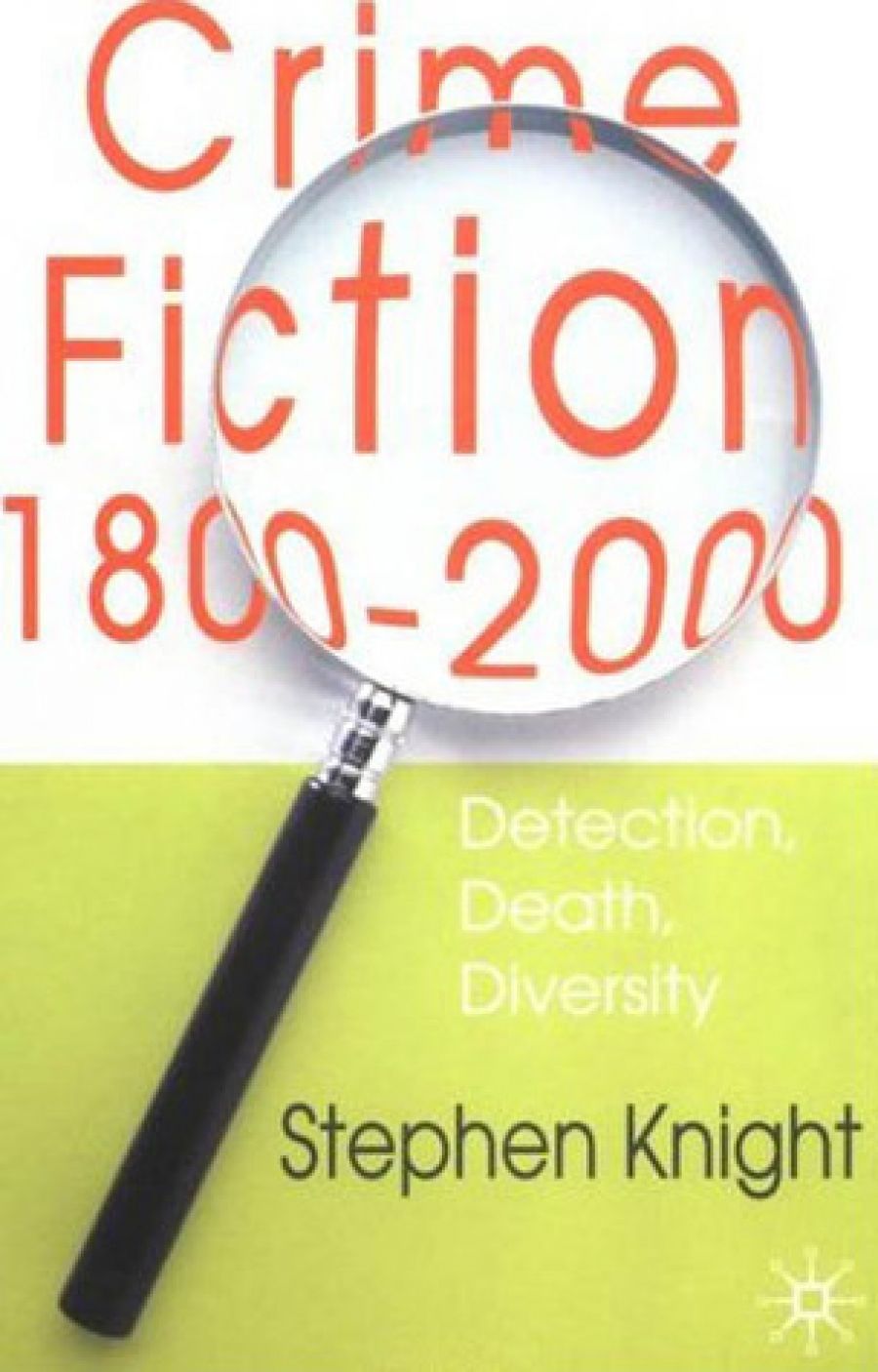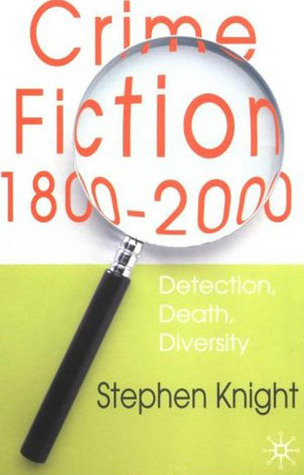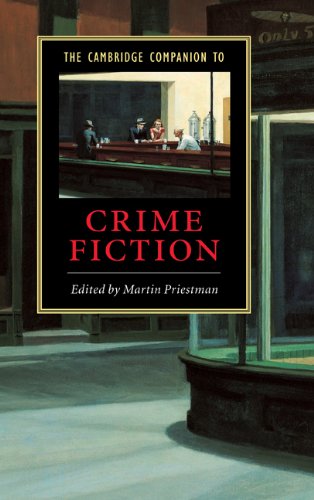
- Free Article: No
- Contents Category: Literary Studies
- Review Article: Yes
- Article Title: The Great Detective
- Online Only: No
- Custom Highlight Text:
‘It is escape not from life, but from literature.’
(Marjorie Nicolson on the detective genre,
‘The Professor and the Detective’, 1929)
I began reading crime fiction in the 1950s and became serious about it in the 1960s, searching out what scholarship there was then about its history and development, its types and practitioners. So I am probably an atypical reader (and reviewer) of these two books. I read them with the pleasure of familiarity and recognition, being reminded of things I hadn’t thought of in a long time. No little part of that pleasure lies in seeing how others assemble and weigh the components of this genre’s history.
- Book 1 Title: Crime Fiction
- Book 1 Subtitle: 1800-2000: Detection, Death, Diversity
- Book 1 Biblio: Palgrave, $40pb, 272pp
- Book 1 Cover Small (400 x 600):

- Book 1 Cover (800 x 1200):

- Book 2 Title: The Cambridge Companion to Crime Fiction
- Book 2 Biblio: CUP, $49.95pb, 287pp
- Book 2 Cover Small (400 x 600):

- Book 2 Cover (800 x 1200):

As scholars of literature, the writers acknowledge that most literature contains or involves crime of one sort or another. They provide definitions, therefore, that limit the area of study to the last two centuries of (mostly) English and American fiction in which crime is the central issue, preferring the term ‘crime fiction’ to the earlier labels of ‘mystery stories’ and ‘detective stories’. The first half of both books is arranged chronologically, examining the steady coming together of various elements from the eighteenth century (grisly murder pamphlets, and sermons, a popular printed literature of the time); then Newgate novels chronicling highwaymen, thieves and other criminal lowlife; their successors, mid-Victorian ‘sensation’ novels; and arriving at the end of the nineteenth century with the modern crime genre fully constituted.
The analysis attends not only to the strictly literary developments (themes, characters, genres, forms, authors, devices) but also to the social and cultural contexts within which the literature developed – why and how it changed as it did when it did. Both books document the same creation myth: the conception or arrival, finally, of that key figure ‘the detective’, and the social changes underlying it. Both books give pride of place to the establishment, from 1829 onwards, of modern police forces with detective branches. This institutional event was quickly exploited by popular literature, initially as ‘authentic’ memoirs of ‘real’ police detectives. Following that, Martin Kayman (in The Cambridge Companion to Crime Fiction) notes a more gradual development, ‘the emergence of the intellectual professions as new repositories of social power’, from which comes a wave of professional and scientific detectives in the second half of the nineteenth century. The crowning moment, the climax of this century-long process, is the arrival of Sherlock Holmes, who, according to Kayman, is ‘the personification of “the Great Detective”: he is a unique creation, whose professional standing is validated by no other institution but himself – and his readers’.
In both books, Knight distinguishes the late nineteenth-century crime fiction scene from that of the twentieth century in terms of form and audience. The principal length in crime fiction in the late nineteenth century was the short story, giving way to the novel in the twentieth; and the nineteenth-century magazines running crime short stories were mainly aimed at male readers, whereas the early twentieth-century lending libraries specialised in crime novels and seventy-five per cent of their users were women.
In dealing with the first half of the twentieth century, both Knight’s and Priestman’s books split into a parallel chronology of, first, the puzzle–clue genre and, second, other hard-boiled writing. In the Cambridge Companion, David Seed’s ‘Spy Fiction’ is an excellent chapter, as is Dennis Porter’s ‘The Private Eye’. Porter states: ‘One of the most widely imitated features of Red Harvest is [Dashiell] Hammett’s use of the first person as narrative voice and as point of view, since together they embody a whole way of observing and representing the world. Not only is what is said important but how it is said and the voice that says it.’ Sita A. Schutt’s ‘French Crime Fiction’ is a compact, pointed demonstration of the relations and differences between French and Anglophone traditions (don’t miss her riff on Inspector Maigret’s Oedipal inversion).
David Glover’s ‘The Thriller’ opens with a discussion of the term’s meaning and decides that, from the 1930s to the 1950s, it is what we would call noir writing, a narrow view that excludes key writers of the period such as Eric Ambler (who is also given little attention in the earlier chapter on ‘Spy Fiction’). Glover does mark the breakthrough in grafting the theme of sexual obsession onto the hard-boiled novel in William Faulkner’s Sanctuary (1931) and James S. Cain’s The Postman Always Rings Twice (1934). Andrew Pepper’s ‘Black Crime Fiction’ opens with a substantial section summarising and problematising the questions surrounding his topic, followed by a long discussion of Chester Himes, and shorter treatments of his offspring Walter Mosley and James Sallis. The weakest of the essays is Nickianne Moody’s ‘Crime in Film and on TV’, which lacks detail and analysis, and is long on secondary source summaries and potted media history. Laura Marcus closes the book, as Knight does his, with a look at crime fiction’s place in postmodernism. In her chapter, ‘Detective and Literary Fiction’, she pulls together G.K. Chesterton, Borges, Robbe-Grillet, Eco, Thomas Pynchon and Paul Auster in an analysis that puts crime fiction at the centre of modernist and postmodernist twentieth-century literature. The volume concludes with an excellent bibliography.
Knight’s book closely resembles Priestman’s; one suspects that both authors unknowingly submitted nearly identical book proposals to their publishers. Knight organises his study around three ‘D’ sections, the major shifts of crime fiction: how the detective became central to the genre by the end of the nineteenth century; how death becomes the focus of crime fiction in both the puzzle–clue and private-eye story up to World War II; and how diversity set in after that war. Only the middle section, on death, differentiates Knight’s overall structure from Priestman’s: he shows how crimes against property are replaced by murder/death as the central topic of crime fiction, and the changes that wrought.
Knight’s examples are sourced widely and include writing from outside Britain and the US (Australia, New Zealand, Ireland, Scotland, Canada and South Africa). In general, his range of specific examples is greater, undercut somewhat by a tendency to cite value judgments from other writers. He is certainly broader and deeper in his treatment of black detective fiction, and his unexpected inclusion of Ishmael Reed’s infrequently mentioned Mumbo Jumbo (1972) as a postmodern example thereof is sharp, as are the examples he gives in his ‘Generic Violence’ section. On the downside, Knight attempts to cram in as much information and detail as possible without losing sight of his analytic structures and, at times, approaches overload. There is a good bibliography and a useful chronology of key publications and events.
Within the obvious constraints facing any single-volume guide to a longstanding, lively, diverse and controversial literary phenomenon, both volumes succeed: they are thought-ful, scholarly, knowledgeable about their subject and largely free of specialised jargon. They are measured and formal rather than conversational or passionate, required as they are to work from the middle distance.


Comments powered by CComment